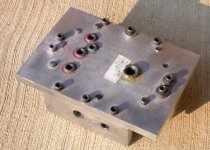Hi there!
I am looking to build some production jigs/fixtures for drilling die-cast aluminum enclosures on four or five faces. I've done quite a bit of research and planning and have finally found what I believe to be the best option for me. What I need help with is tips for assembling these fixtures, as I am very new to metal working with a limited tool set. However, I can purchase new equipment (within reason) and have a steady hand with great attention to detail. The reason I'm not simply having a metal shop do this work is that the ones in our area have been very flaky and we can't seem to get them to actually do the work for us...
The fixtures will be made of 1/2" thick 6061 Aluminum. There will be a top face with about 3 sides. The enclosures will drop in the back side and be held in place by alloy dowel pins, and lock into place with a bit of an aluminum lock that slides into place. The dowel pins must be super accurate to get a snug hold. The 3 sections of aluminum will have holes drilled in them with press-fit bushings to be used as drill guides. Drilling will be done with your average drill press for production, and there will be a gap between the fixture and enclosure to let chips escape.
My questions:
Any other tips for this are greatly appreciated and I'm sure I'll have some more questions as I think some more. Thanks so much!
I am looking to build some production jigs/fixtures for drilling die-cast aluminum enclosures on four or five faces. I've done quite a bit of research and planning and have finally found what I believe to be the best option for me. What I need help with is tips for assembling these fixtures, as I am very new to metal working with a limited tool set. However, I can purchase new equipment (within reason) and have a steady hand with great attention to detail. The reason I'm not simply having a metal shop do this work is that the ones in our area have been very flaky and we can't seem to get them to actually do the work for us...
The fixtures will be made of 1/2" thick 6061 Aluminum. There will be a top face with about 3 sides. The enclosures will drop in the back side and be held in place by alloy dowel pins, and lock into place with a bit of an aluminum lock that slides into place. The dowel pins must be super accurate to get a snug hold. The 3 sections of aluminum will have holes drilled in them with press-fit bushings to be used as drill guides. Drilling will be done with your average drill press for production, and there will be a gap between the fixture and enclosure to let chips escape.
My questions:
- I have a standard drill press, bits, cross-slide vise, digital calipers, center punches, etc. I will print out a template for the holes on the jig and tape it to the aluminum before making center punch marks. What is the best way to achieve the most accurate hole positions? I need accuracy to about 1/2mm.
- For a bushing that has a listed outer diameter of 3/4", how should I drill that hole? I've read many differing opinions. Best I can tell is to drill it to size and use a C-clamp to press the bushings in?
Any other tips for this are greatly appreciated and I'm sure I'll have some more questions as I think some more. Thanks so much!





